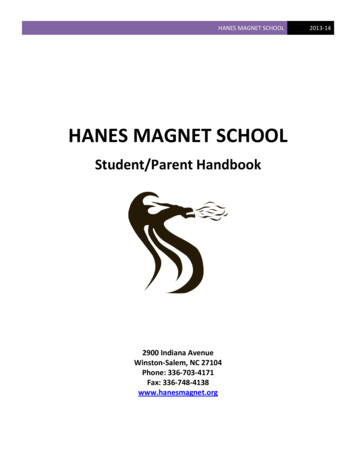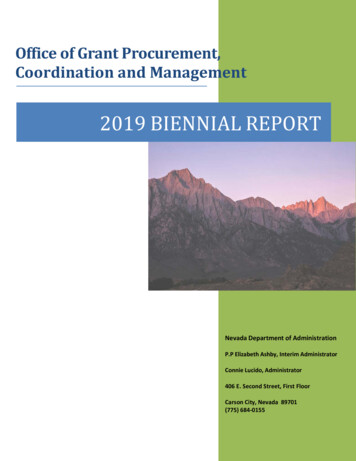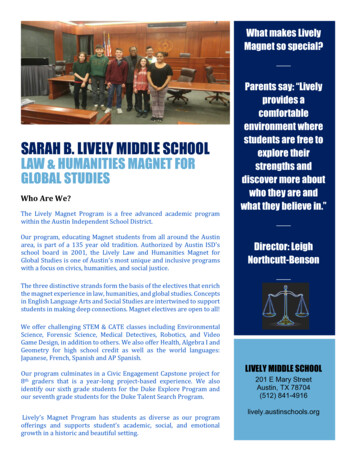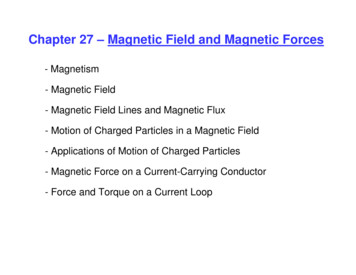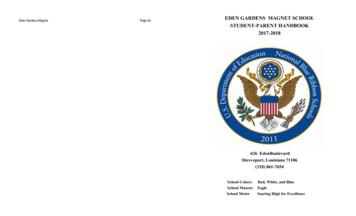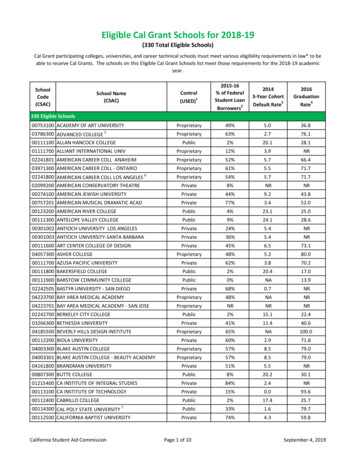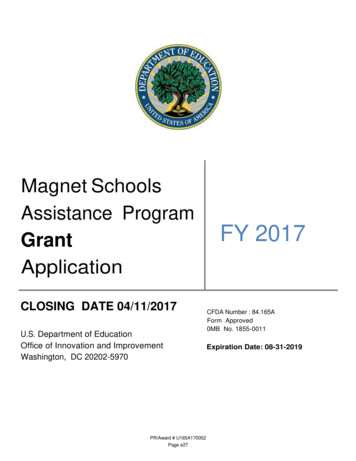
Transcription
Magnet SchoolsAssistance ProgramGrantApplicationCLOSING DATE 04/11/2017U.S. Department of EducationOffice of Innovation and ImprovementWashington, DC 20202-5970PR/Award # U165A170052Page e27FY 2017CFDA Number : 84.165AForm Approved0MB No. 1855-0011Expiration Date: 08-31-2019
CONTENTSPRIORITY 1—NEED FOR ASSISTANCE .1(a) The costs of fully implementing the magnet schools project as proposed . 1(b) The resources available to the applicant to carry out the project . 7(c) The extent to which the costs of the project exceed the applicant’s resources . 7(d) The difficulty of carrying out the project . 9PRIORITY 2—NEW OR REVISED MAGNET SCHOOL PROJECTS and STRENGTH OFEVIDENCE TO SUPPORT NEW PROJECTS . 12PRIORITY 3—SELECTION OF STUDENTS . 17PRIORITY 4—INCREASING RACIAL INTEGRATION AND SOCIOECONOMICINTEGRATION . 17SELECTION CRITERIA (a): DESEGREGATION. 22(1) The effectiveness of the plan to recruit students from different social, economic, ethnic, andracial backgrounds into the magnet schools . 22(2) How it will foster interaction among students of different social, economic, ethnic, andracial backgrounds. . 29(3) How it will ensure equal access and treatment for eligible project participants who havebeen traditionally underrepresented . 36(4) The effectiveness of all other desegregation strategies . 41SELECTION CRITERIA (b): QUALITY OF PROJECT DESIGN . 48(1) The manner and extent to which the magnet school program will improve student academicachievement for all students . 48(2) The extent to which the applicant demonstrates that it has the resources to operate theproject beyond the length of the grant . 69(3) The extent to which the training or professional development services to be provided by theproposed project are of sufficient. 72(4) The extent to which the proposed project is supported by strong theory . 75SELECTION CRITERIA (c): QUALITY OF MANAGEMENT PLAN . 101(1) The adequacy of the management plan to achieve the objectives of the proposed project ontime and within budget . 101PR/Award # U165A170052Page e28
(2) How the applicant will ensure that a diversity of perspectives are brought to bear in theoperation of the proposed project . 108SELECTION CRITERIA (d): QUALITY OF PERSONNEL. 111Qualifications of personnel and experience and training in fields related to the objectives ofthe project, including curriculum development and desegregation . 111SELECTION CRITERIA (e): QUALITY OF PROJECT EVALUATION . 121(1) The extent to which the methods of evaluation will, if well-implemented, produce evidenceof promise . 123(2) The extent to which the methods of evaluation include the use of objective performancemeasures that are clearly related to the intended outcomes of the project and will producequantitative and qualitative data to the extent possible . 133(3) The extent to which the costs are reasonable in relationship to the objectives, design, andpotential significance of the proposed project . 146PR/Award # U165A170052Page e29
PRIORITY 1—NEED FOR ASSISTANCE(a) The costs of fully implementing the magnet schools project as proposedThere are two Connecticuts. One is affluent, suburban, and predominantly white. Theirchildren attend schools with many resources supported by a property tax base that is formidable.The other is poor urban, and predominantly African-American and Hispanic. Their childrenattend schools that have fewer resources supported by a weak tax base. In national comparisons,Connecticut consistently has one of the largest achievement gaps between white students andblack and Hispanic students. For example, on the 2015 administration of the NationalAssessment of Educational Progress (NAEP), the gap for NAEP reading at the fourth gradebetween white and black students was fourth highest in the country and between white andHispanic students was sixth highest in the country.In Connecticut, if you are an African-American or Hispanic child from a low-incomehome, it is almost a certainty that your neighborhood school will be a low performing,segregated school. Connecticut utilizes a five category school classification system, withCategory 1 representing the highest rating. In 2015-16, through the accountability system,Connecticut identified 135 low- performing schools (categories 4 and 5), classified asTurnaround or Focus. Turnaround schools are the lowest performing schools in the state, andFocus Schools are those schools with the lowest academic performance or graduation rate for theHigh Needs subgroup. 65% (88) of the state’s focus and turnaround schools are located in fivedistricts, all of which are overwhelmingly African-American and Hispanic, and poor: NewHaven (26 schools), Hartford (22), Bridgeport (19), Waterbury (14), and New Britain (7).Hartford’s high number of low-performing schools demonstrates tremendous need, andthe district has been designated an Alliance District, meaning it is one of the lowest performing1PR/Award # U165A170052Page e30
districts across the state. Four percent of Connecticut’s public schools are operated by HartfordPublic Schools (HPS), but Hartford schools account for 33% of Turnaround schools and 9% ofFocus schools. None of Hartford’s schools received the state’s highest performanceaccountability rating, and only six schools were rated as Category 2, meaning the school fellwithin the average range for performance. The overwhelming majority of Hartford’s communityschools are low-achieving and economically and racially isolated.Hartford’s demographics are challenging. It is one of the country’s poorest cities, and thepoorest in Connecticut. Per capita income, according to the 2013 American Community Survey,was 16,619 as compared to 37,892 for the state as a whole, and more than 3,000 less thanBridgeport, which is Connecticut’s second poorest city. Hartford’s mean ( 42,468) and median( 29,430) income levels are also the lowest in Connecticut. This is in stark contrast toneighboring West Hartford, which has a median income of 86,569. Fifteen percent of Hartfordresidents age 25 and older have a Bachelor’s degree or higher, as compared to 60% in WestHartford and 37% in Connecticut. Approximately 21,400 students are enrolled in Hartford PublicSchools, of whom 78% are low-income based on free and reduced price lunch eligibility; 18%are English Language Learners (ELL); and 89% are minority students.Hartford’s struggle to provide high quality education in a racially and economicallyisolated context is not a new struggle. Frustrated by the lack of quality education, on April 18,1989, eighteen school-aged Hartford residents filed a civil rights claim against the State ofConnecticut in the landmark case Sheff v. O’Neill (Sheff). The plaintiffs alleged constitutionalviolations to the fundamental right to equal education opportunity.On July 9, 1996, the Connecticut State Supreme Court held that public school students inthe City of Hartford attended schools that were racially, ethnically, and economically isolated in2PR/Award # U165A170052Page e31
violation of the Connecticut Constitution. The original complaint, written in 1989, still holds truetoday and gives voice to all Hartford students who are denied the opportunity to attend a highperforming school. "This complaint is brought on behalf of school children in the Hartfordschool district, a great majority of whom -- 91 percent -- are black or Hispanic, and nearly half ofwhom -- 47.6 percent -- live in families that are poor. These children attend public schools in adistrict that is all but overwhelmed by the demand to educate a student population drawn soexclusively from the poorest families in the Hartford metropolitan region. The Hartford schooldistrict is also racially and ethnically isolated: on every side are contiguous or adjacent schooldistricts that, with one exception, are virtually all-white, and without exception, are middle- orupper-class in socioeconomic composition The educational achievement of school childreneducated in the Hartford school district is not, as a whole, nearly as great as that of studentseducated in the surrounding communities. These disparities in achievement are not the result ofnative inability: poor and minority children have the potential to become well-educated, as doany other children. Yet the State of Connecticut, by tolerating school districts sharply separatedalong racial, ethnic, and economic lines, has deprived the plaintiffs and other Hartford childrenof their rights to an equal educational opportunity, and to a minimally adequate education -rights to which they are entitled under the Connecticut Constitution and Connecticut statutes."The court was unequivocal. Racial segregation, whether de jure or de facto, is illegal.Accordingly, the State was placed under a mandatory court order to remedy the Hartford PublicSchools' racial isolation and disparity in educational opportunities. Three programs weredesigned to attain this goal: the interdistrict magnet program, which creates high quality magnetschools that enroll Hartford and suburban students; the Open Choice Program, which encourages3PR/Award # U165A170052Page e32
Hartford students to attend schools in suburban districts; and charter schools, which attractHartford and suburban students.The Capitol Region Education Council (CREC) manages the Open Choice program andoperates seventeen interdistrict magnet schools in the Hartford region. These programs aredesigned to support the State of Connecticut in meeting its responsibility, as outlined in the StateSupreme Court’s decision, to provide Hartford-resident minority students with the opportunity toattend high quality, integrated schools. Gains have been made since 1996, with approximately9,108 Hartford residents enrolled in integrated settings during the 2015-16 school year. Acrossthe greater Hartford region, forty strategically placed interdistrict magnet programs aresuccessfully attracting students from Hartford and the surrounding affluent suburbs. The varietyof themes and locations as well as available bussing encourages socioeconomic and racialdiversity, and ensures that all families have options best suited to individual needs and that theburden of travel to high quality, integrated schools is not placed solely on Hartford families.Nonetheless, thousands of Hartford students are still educated in racially and ethnically isolated,poorly performing schools. Non-magnet Hartford schools are on average 96% minority incontrast to CREC’s magnet schools, which are approximately 70% minority.In December 2013, the State and the plaintiffs entered into the Phase 3 Stipulation andProposed Order for Sheff v. O’Neill (Sheff v. O’Neill, 2013), acknowledging that “the parties arecognizant the efforts will need to continue beyond June 30, 2014, to further reduce racial, ethnic,and economic isolation Hartford-resident minority students.” Pursuant to the Phase 2 agreementin 2010, and explicitly continued in Phase 3, the State Department of Education created theRegional School Choice Office (RSCO), to implement the recruitment, application and selectionprocess for all school choice programs that are part of the Sheff settlement, including magnet4PR/Award # U165A170052Page e33
schools and the Open Choice program. The purpose of this centralization was to produce aseamless school choice program for the entire Hartford region. There is one application, onelottery and one voice to explain to parents the high quality choices that are available to them.This project is product of the RSCO collaboration and describes a regional planthat will reduce racial, ethnic and socioeconomic isolation throughout Connecticut’sgreater Hartford region. Through grant funds, three existing magnet schools, The MetropolitanLearning Center (MLC), CREC Academy of Science and Innovation (ASI), and CREC PublicSafety Academy (PSA), will be significantly revised and an Open Choice magnet preschool, theEnfield Public Schools Prekindergarten STEAM Academy, will be developed. Althoughoriginally conceived to counter racial and economic isolation, the three existing magnet schoolsare experiencing a shift in demographics, with a steady increase in Black and Hispanicenrollment from approximately 65% to over 70% at each school. In addition, none of theschools have achieved socioeconomic diversity reflective of the Hartford Region. In the 2015-16school year, PSA reached the threshold of students eligible for free and reduced lunch to operateunder the Community Eligibility Provision of the National School Lunch Program, and thepercent of low-income students at ASI (57%) and MLC (42%) is higher than the percent of lowincome students residing in Connecticut (35%). The three revised schools will be developed andoperated by CREC, and the fourth school will be developed and operated by an Open Choicedistrict, Enfield Public Schools. The infusion of funds needed to support initial implementationand development of the proposed magnet programs will require financial resources beyondcurrent levels.State funds cover student transportation and the costs of the construction and renovationof schools that become interdistrict magnets. In addition, the basic operations for magnet schools5PR/Award # U165A170052Page e34
are supported by state funding and tuition from local districts. These funds are insufficient tocover the full costs of magnet theme development, including professional development andspecialized materials and equipment needed to create high quality, theme specific programs, vitalif a magnet school is to attract and retain a diverse population of students. Each aspect of theproposed project is designed to build professional and administrative capacity so that schoolswill develop the resources, systems and knowledge to continue successful programming after thegrant cycle has ended. The State has approved these four schools as part of its plan to reduce theracial and economic isolation of Hartford resident minority students. All four schools will besupported by the RSCO and the State of Connecticut Department of Education.The CREC/Enfield consortium is requesting approximately 3 million per year toimplement this project. This will fund a project director, a project coordinator, 7 magnetresource teachers, 3.5 family and community engagement specialists, professional development,theme supplies and equipment, and project evaluation. Because the State must meet thebenchmarks established following the Sheff case, the four schools described in this applicationwill operate whether or not this MSAP project is approved, though three of the four will notimplement a revised theme and the fourth will do so with very limited resources. Without MSAPfunds, personnel essential to the thematic development and implementation of these schoolscannot be hired. Without the MSAP supported teachers, professional development, and suppliesand equipment, the activities described in this proposal that make each school unique andimprove instruction will be significantly hindered.The total cost of this MSAP program, if fully funded and implemented, is 3,089,294 for thefirst year, 2,900,786 for year 2, 2,935,469 for year 3, 2,928,622 for year 4, and 2,923,5886PR/Award # U165A170052Page e35
for year 5. The project will serve 1,564 students in year 1; 2,137 students in year 2; 2,222students year 3; 2,292 students in Year 4; and 2,310 students in Year 5.(b) The resources available to the applicant to carry out the project if funds under the programwere not provided;(c) The extent to which the costs of the project exceed the applicant’s resourcesConnecticut spent 313 million for magnet schools in fiscal year 2017 and an additional 11 million exclusively on the Sheff remedy. These funds are used to support basic operationsand transportation for 126 programs and schools throughout the state. Despite standard annualincreases in expenditures such as increases in salaries and benefits, the per pupil grant of 10,443for Sheff magnet schools remained flat for six consecutive years and was cut by 3.7% for the2016-17 school year. For the 2018 fiscal year, Connecticut is facing a projected 1.7 billionbudget deficit. Given the state of Connecticut’s economy, solving the current fiscal issues willrequire long-term efforts.As a Regional Educational Service Center (RESC), CREC has no power to tax propertyor derive income through taxation of any type. The majority of CREC’s funding comes from theState’s fixed per pupil grant as described above. The school districts in which magnet studentsreside contribute between 4,125 and 5,300 per pupil to make up the difference between thestate grant and the cost of educating the student. Any increase in district tuition charges must beapproved by the CREC Council, which is comprised of Board of Education representatives from36 districts in the Greater Hartford Region. Given the current financial difficulties faced by thelocal school districts and municipalities, CREC must balance the costs of running high qualitymagnet schools that meet the needs of all learners and further burdening already-stretchedcommunities in the Hartford area. This inability to access adequate funding has a direct impacton CREC students, resulting in reduced program and services. For example, CREC is no longer7PR/Award # U165A170052Page e36
able of offer summer school, and students must return to district for mandated services. CRECmust use all available funds to support the essential operations of existing programs. As a result,a gap exists between current funding levels and the costs associated with developing new andrevised high-quality magnet programs.The state’s budget crisis also severely limits the town of Enfield’s ability to invest incritical thematic resources for the proposed preschool program. Despite small increases inenrollment since the 2014-15 school year, Enfield experienced a 2% reduction in state educationaid from 2016 to 2017, with more cuts expected in the upcoming fiscal years. If passed by thelegislature, the governor’s proposed budget for 2018 would amount to a 9% cut in state aid. Thefull impact of the 2018 and 2019 biennial budget will not be known until late July of 2017, but itis likely that magnet funding and local education aid will experience cuts. As a result, federalaid has become profoundly important to fully support the thematic development of the proposedmagnet programs. Neither CREC nor Enfield has the resources to support the increase infunding needed to support the proposed grant activities.When sufficient resources are provided, there has been a clear impact on the educationalopportunities afforded to Hartford students. Six of the eight CREC/Hartford consortium magnetschools funded in the 2010 MSAP cycle were selected to receive merit awards from MagnetSchools of America in 2016, recognizing them as among the best schools of their kind in theUnited States. In each of the past three years, the CREC Academy of Aerospace andEngineering, a school funded through the 2010 MSAP cohort, has been named one of the topthree high schools in the state by US News and World Report. The Civil Rights Project at UCLAfound that CT magnet schools, particularly in the Hartford region, reduce segregation andimprove educational outcomes (Orfield and Ee 2015). The Connecticut State Department of8PR/Award # U165A170052Page e37
Education conducted an evaluation of choice programs and found that students in magnetschools outperform their peers in non-magnet schools, with students in RESC run schoolsperforming at the highest levels (Mooney et al 2015). CREC’s success in promoting highachievement among all students demonstrates that magnet schools, when adequately funded,have the potential to close the achievement gap and provide equitable access to high qualityeducational opportunities.The Consortium partners understand that the most expensive period for a magnet is whenit is first developing and implementing its theme. Significant investment in specializedprofessional development and supplies are necessary during the startup period and lessen oncethe program is well-established. While magnet schools always require marketing efforts,significant resources are needed in the early stages of program redesign and development to planthe marketing strategy and create recruitment materials to effectively promote new programs.Many of the schools in Hartford’s suburbs are high-performing, requiring magnet schools toattract families who may not naturally consider looking outside of their immediate communitiesfor schooling. In addition, Hartford is traditionally a highly transient district and educatingfamilies on school choice options is a constant need. Well-utilized resources for marketing canprovide a significant boost to efforts aimed at attracting a diverse applicant pool to new orrevised programs.(d) The difficulty of carrying out the project for which assistance is sought, including how thedesign of the magnet schools project – e.g., the type of program proposed, location of the magnetschool within the LEA - impacts on the applicant’s ability to successfully carry out the approvedplan.The extreme income inequality across the Hartford region presents challenges toeffectively carrying out the court ordered plan described in this proposal. When racial andeconomic isolation is the norm, the choice to attend a magnet school can feel like a risk. This is9PR/Award # U165A170052Page e38
true for all parents, suburban and urban. When attending a magnet school, a student and theirparents give up the convenience and comfort of their neighborhood school, often sacrificing timeand sleep for a longer commute. This impact is felt socially as well, with friendships spreadacross the region rather than concentrated in local school zones. While the city of Hartford hasstruggled with lack of resources and high need, the majority of suburban schools consistentlyperform well on state measures. As such, suburban families are often less motivated to consider amagnet school. Nonetheless, Sheff schools, particularly those supported by MSAP funds, havebeen able to mitigate barriers through strategically placed theme-based schools in Hartford andsurrounding suburban towns.When provided the necessary funding to fully develop well-researched, high-interestthemes, interdistrict magnets in the Hartford region have a successful history attracting asubstantial number of suburban and middle class students and successfully raising achievementlevels for all students. The CREC Academy of Aerospace and Engineering received MSAP fundsin the 2010 cycle and currently enrolls a diverse student population of 26% Black, 29%Hispanic, and 30% white, and 48% qualifying for free or reduced lunch. On the 2016administration of the SAT, 85% of Aerospace students met or exceeded achievement levels forELA and 70% met or exceeded achievement levels for math, outperforming the CT averages of65% for ELA and 39% for math. With appropriate funding for theme resources and professionaldevelopment, interdistrict magnet schools are successfully raising achievement for all enrolledstudents and are an effective solution to rectify racial and socioeconomic isolation.While many of CREC’s magnet schools are making progress towards closing theachievement gap, the three schools identified for significant revision in this proposal havestruggled. Lack of funding to develop rich, theme-based curricula, purchase important theme10PR/Award # U165A170052Page e39
resources, and provide intensive professional development have resulted in poor performanceacross a variety of indicators on the state’s 2015-16 school profile and performance reports. Onthe math portion of the SAT (state standardized test for Grade 11), only 11.9% of ASI students,17.2% of MLC students, and 8.2% of PSA students met or exceeded the achievement level. Theresults for ELA were better, but only 62.7% of ASI, 50.6% of MLC, and 27.4% of PSA studentsmet or exceeded achievement levels. At all project schools, black and Hispanic students accountfor a disproportionate number of suspensions and expulsions. For example, black studentsaccount for 36.16% of the student population across the three schools, but comprise 50.11% ofall suspensions/expulsions. In addition, across the three schools an average of 27% of studentswere suspended, compared to the district average of 10%.While CREC’s magnet schools and the Open Choice program historically draw a largeracially and socioeconomically diverse applicant pool, the schools seeking revision in thisapplication have struggled to maintain application levels consistent with the rest of the district.For the 2017-18 lottery, ASI received only 17 first choice Hartford resident applicants for grade6, far below the target of 55. 79% of MLC’s first choice applicants for Grade 6 identify as Blackor Hispanic, placing the school at risk of not meeting the Sheff desegregation standard. Likewise,81% of PSA’s grade 9 first choice applicant pool identifies as black or Hispanic, and the schoolreceived the district’s lowest number of first-choice applicants. The Enfield Public Schoolsprekindergarten program, which will become STEAM Academy, received fewer Hartfordapplications than the number of seats offered during the on-time lottery application period.While the lottery application does not capture poverty data, there are concerns related tosocioeconomic isolation at the target schools, since between 70 and 79% of applicants to the11PR/Award # U165A170052Page e40
three secondary schools reside in Connecticut towns with the lowest median incomes and highestconcentrations of poverty.The quality of the educational program and the resources within a school to provide aunique, high quality educational experience will be the decisive factor in convincing parents toenroll their children in a magnet school. The Consortium partners are committed to thedevelopment of unique, theme-based learning environments with the goal of preparing allstudents to succeed in college and beyond. With MSAP funding, every school would provide arigorous and engaging theme-based curriculum and develop twenty-first century skills throughproject-based, technology enhanced learning opportunities.The four schools in this proposal will operate over the next five years; however, MSAPfunding is required to provide high-quality integration of the theme into the core curriculum;instructional resources to support the theme; and professional development to ensuredifferentiated and rigorous learning to attract students from every racial, ethnic and economicbackground. With MSAP support, they will successfully compete with suburban schools.Without MSAP support, these schools will struggle with resource-poor magnet programs,seriously compromising their chances of success. Although the state will continue to providebasic funding to the interdistrict magnet schools, it will not be sufficient to provide resources todevelop schools equipped to effectively carry out the terms of the Sheff settlement.PRIORITY 2—NEW OR REVISED MAGNET SCHOOL PROJECTS and STRENGTHOF EVIDENCE TO SUPPORT NEW PROJECTSTo ensure the best possible outcomes from its MSAP project, the CREC/EnfieldConsortium will implement a variety of research-based programs, practices and strategies (seeSelection Criteria (b) Quality of Project Design). Foundational to the implementation of theproject is the development of school settings that meet all learner needs and encourage positive12PR/Award # U165A170052Page e41
social and emotional development. Alongside revised thematic opportunities, the schools willimplement a variety of strategies aimed at ensuring equal opportunity and access for all students.To support and engage secondary students who have experienced trauma, the secondary schoolswill utilize Cognitive Behavior Intervention for Trauma in Schools (CBITS). To support positivesocial and emotional growth, particularly for students exhibiting challenging behaviors, thePreschool STEAM Academy will implement Second Step. Both of
Safety Academy (PSA), will be significantly revised and an Open Choice magnet preschool, the Enfield Public Schools Prekindergarten STEAM Academy, will be developed. Although originally conceived to counter racial and economic isolation, the three existing magnet schools
